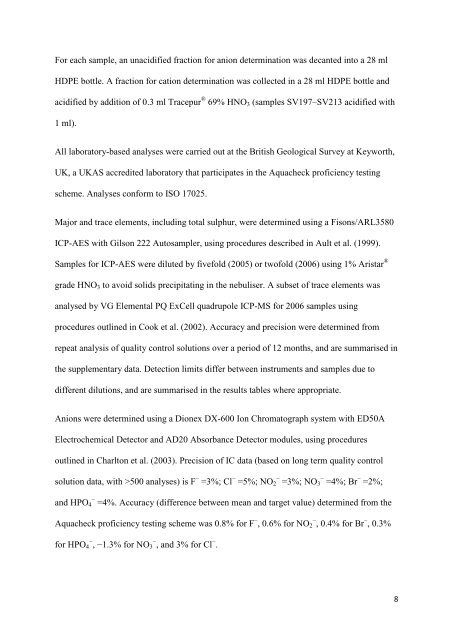Alkaline sulphate fluids produced in a magmatic hydrothermal system
Alkaline sulphate fluids produced in a magmatic hydrothermal system
Alkaline sulphate fluids produced in a magmatic hydrothermal system
Create successful ePaper yourself
Turn your PDF publications into a flip-book with our unique Google optimized e-Paper software.
For each sample, an unacidified fraction for anion determ<strong>in</strong>ation was decanted <strong>in</strong>to a 28 ml<br />
HDPE bottle. A fraction for cation determ<strong>in</strong>ation was collected <strong>in</strong> a 28 ml HDPE bottle and<br />
acidified by addition of 0.3 ml Tracepur ® 69% HNO 3 (samples SV197–SV213 acidified with<br />
1 ml).<br />
All laboratory-based analyses were carried out at the British Geological Survey at Keyworth,<br />
UK, a UKAS accredited laboratory that participates <strong>in</strong> the Aquacheck proficiency test<strong>in</strong>g<br />
scheme. Analyses conform to ISO 17025.<br />
Major and trace elements, <strong>in</strong>clud<strong>in</strong>g total sulphur, were determ<strong>in</strong>ed us<strong>in</strong>g a Fisons/ARL3580<br />
ICP-AES with Gilson 222 Autosampler, us<strong>in</strong>g procedures described <strong>in</strong> Ault et al. (1999).<br />
Samples for ICP-AES were diluted by fivefold (2005) or twofold (2006) us<strong>in</strong>g 1% Aristar ®<br />
grade HNO 3 to avoid solids precipitat<strong>in</strong>g <strong>in</strong> the nebuliser. A subset of trace elements was<br />
analysed by VG Elemental PQ ExCell quadrupole ICP-MS for 2006 samples us<strong>in</strong>g<br />
procedures outl<strong>in</strong>ed <strong>in</strong> Cook et al. (2002). Accuracy and precision were determ<strong>in</strong>ed from<br />
repeat analysis of quality control solutions over a period of 12 months, and are summarised <strong>in</strong><br />
the supplementary data. Detection limits differ between <strong>in</strong>struments and samples due to<br />
different dilutions, and are summarised <strong>in</strong> the results tables where appropriate.<br />
Anions were determ<strong>in</strong>ed us<strong>in</strong>g a Dionex DX-600 Ion Chromatograph <strong>system</strong> with ED50A<br />
Electrochemical Detector and AD20 Absorbance Detector modules, us<strong>in</strong>g procedures<br />
outl<strong>in</strong>ed <strong>in</strong> Charlton et al. (2003). Precision of IC data (based on long term quality control<br />
solution data, with >500 analyses) is F − =3%; Cl − =5%; NO − 2 =3%; NO − 3 =4%; Br − =2%;<br />
and HPO − 4 =4%. Accuracy (difference between mean and target value) determ<strong>in</strong>ed from the<br />
Aquacheck proficiency test<strong>in</strong>g scheme was 0.8% for F − , 0.6% for NO − 2 , 0.4% for Br − , 0.3%<br />
for HPO − 4 , −1.3% for NO − 3 , and 3% for Cl − .<br />
8
















